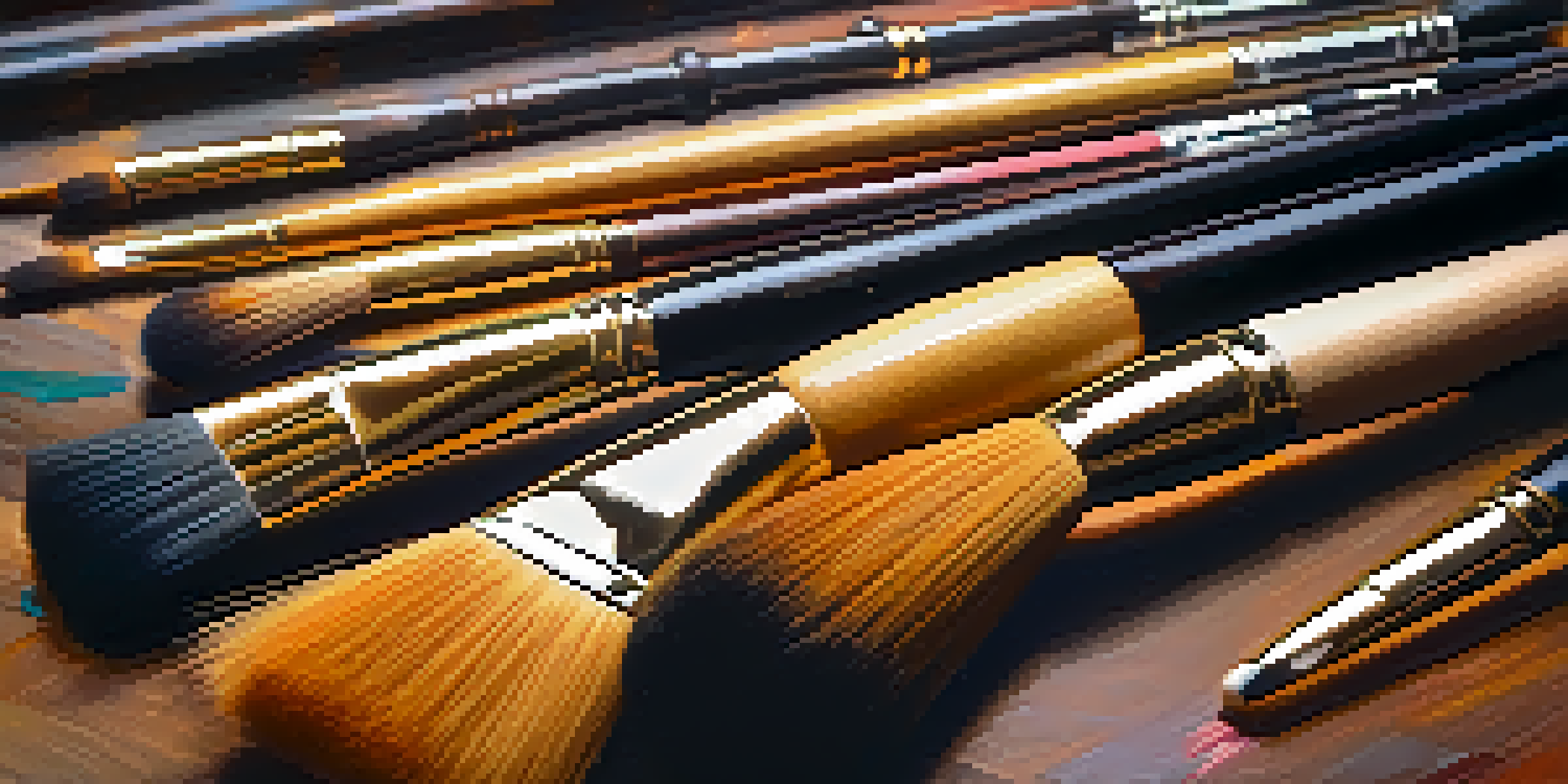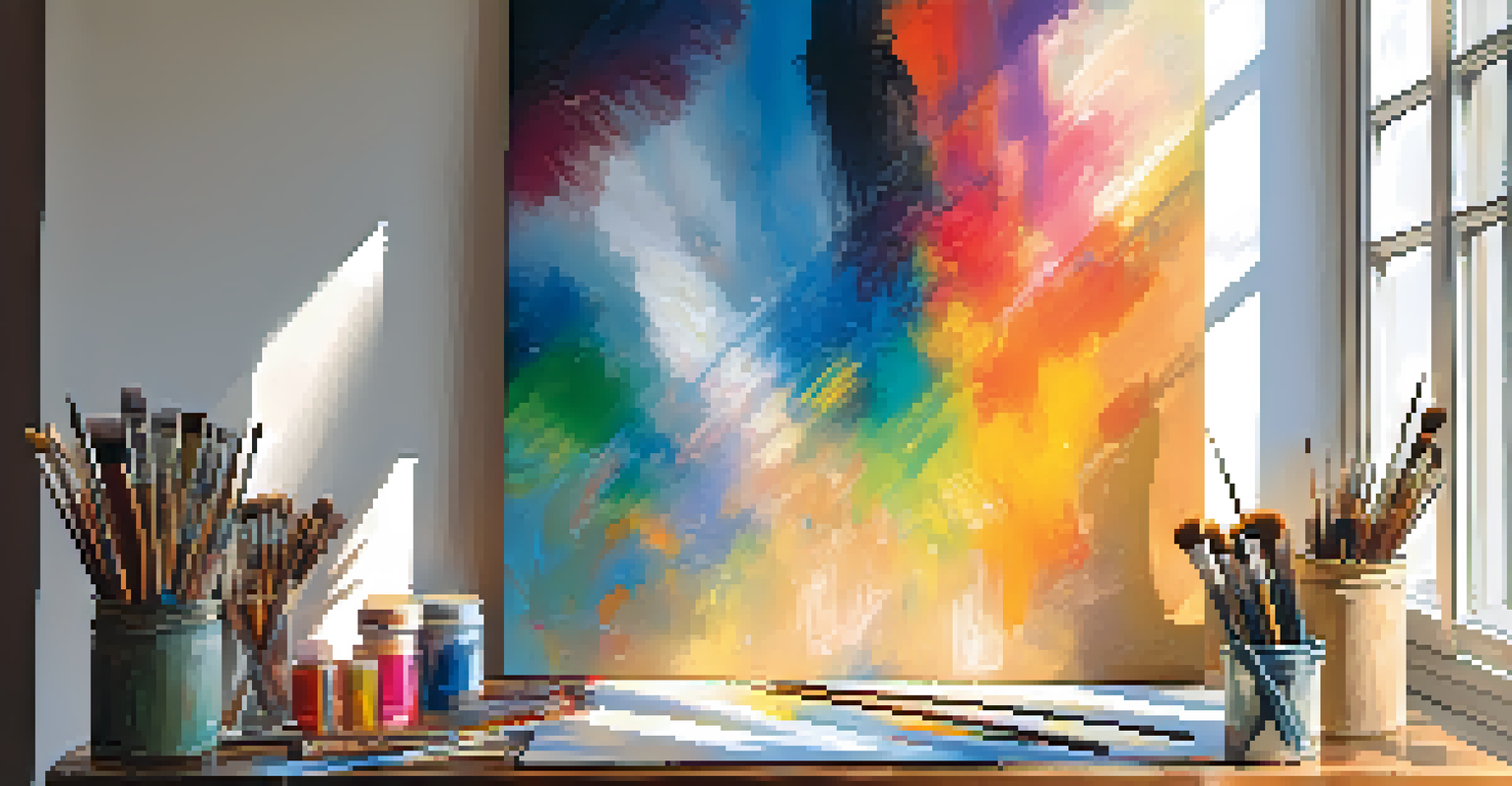The Role of Brushes in the Development of Painting Techniques

Understanding the Basics of Painting Brushes
Brushes have been a fundamental tool in the artist's arsenal for centuries, serving as a direct connection between the artist and their canvas. The variety of brushes available, from round to flat, each offers unique capabilities that can dramatically influence the outcome of a painting. For instance, a round brush is perfect for detail work, while a flat brush is great for broader strokes and filling in larger areas. This diversity allows artists to experiment and develop their own unique styles.
A brush is a tool that can turn an artist's vision into reality, shaping not just the canvas, but the very essence of expression.
The materials used to create brushes also play a significant role in their effectiveness. Brushes can be made from natural hair, synthetic fibers, or a combination of both, each providing different textures and effects. Natural bristles, like those from sable or hog hair, offer a softness that can create smooth blends, while synthetic brushes tend to be more durable and resilient. Understanding these differences helps artists select the right brush for their specific technique.
Ultimately, the choice of brush can be just as important as the choice of paint. Artists often develop a personal relationship with their brushes, finding specific ones that feel right for their hand and style. This connection can lead to a more intuitive painting process, allowing for greater creativity and expression on the canvas.
Historical Evolution of Brushes in Art
The history of brushes dates back to ancient civilizations, where rudimentary tools were crafted from animal hair and plant fibers. These early brushes were primarily used for decorative art and writing, laying the foundation for modern painting techniques. As societies evolved, so did the complexity and variety of brushes, reflecting the changing needs and styles of artists throughout history.

During the Renaissance, the development of new techniques and the rise of oil painting significantly influenced brush design. Artists began to experiment with different shapes and sizes, creating brushes that allowed for more detailed work and fine lines. This period marked a turning point in the way artists approached their craft, as brushes became essential for achieving depth and realism in their paintings.
Diverse Brushes Enhance Artistic Styles
Different types of brushes allow artists to explore unique techniques and develop their personal styles.
By the 18th and 19th centuries, the Industrial Revolution further transformed brush production, making them more accessible to artists of all skill levels. This democratization of art tools allowed for a flourishing of creativity, as more people began to explore painting as a hobby or profession. The evolution of brushes thus parallels the evolution of painting techniques, illustrating how tools can shape artistic expression.
Brush Techniques That Changed Painting Forever
Different brush techniques have played a pivotal role in the evolution of painting styles. For example, the technique of 'dry brushing,' where a dry brush is used to apply paint, creates a textured look that can add depth and dimension to a piece. This method became popular among Impressionist artists, who sought to capture the fleeting effects of light and atmosphere in their work.
The right brush can make all the difference; it’s the bridge between imagination and creation.
Another significant technique is 'blending,' which involves using a brush to smooth out transitions between colors. This technique is crucial in creating realistic skin tones or atmospheric backgrounds in landscapes. Artists like Velázquez and Rembrandt mastered these techniques, allowing their paintings to convey emotion and intensity.
Finally, the 'wash' technique, often used with watercolor paints, employs a wet brush to create fluid, transparent layers of color. This method highlights the importance of water control and brush pressure in achieving desired effects. Each of these techniques showcases the diverse capabilities that brushes bring, highlighting their importance in the development of painting.
The Influence of Brush Materials on Technique
The materials used to make brushes can greatly influence an artist's technique. For instance, a soft, natural bristle brush allows for smooth, flowing strokes, making it ideal for blending colors. In contrast, a stiff synthetic brush can produce bold, sharp lines, perfect for creating defined shapes and edges. Artists often experiment with different materials to discover what best suits their style.
Moreover, the type of paint used can affect how brushes perform. Oil paints, which are thicker, work well with stiff brushes, allowing for impasto techniques where paint is applied in thick layers. On the other hand, watercolors require softer brushes that can hold water and create delicate washes. Understanding these dynamics helps artists choose the right combination of materials and techniques for their artwork.
Brushes Reflect Cultural Traditions
The design and use of brushes vary across cultures, showcasing the influence of historical and artistic contexts.
This relationship between brush materials and painting techniques is not just a matter of preference; it can also dictate the overall aesthetic of a piece. Artists who master this interplay can create stunning works that resonate with viewers, showcasing the artistry involved not just in the paint, but in the tools used to apply it.
Innovations in Brush Design Over the Years
Brush design has evolved significantly over the years, with innovations that have expanded the possibilities for artists. Modern brushes now come with ergonomic handles, making them more comfortable to hold for extended periods. This is especially beneficial for professional artists who spend hours working on their craft, allowing for greater precision and control.
Additionally, advancements in synthetic materials have led to the creation of brushes that mimic the performance of natural hair while being more durable and easier to clean. For instance, high-quality synthetic brushes can hold paint well and provide excellent spring, making them a popular choice among both professional and amateur artists. This shift has made it easier for artists to maintain their tools and explore new techniques without the worry of wear and tear.
Moreover, specialty brushes designed for specific effects, such as fan brushes for texture or angled brushes for precision, have opened up new avenues for creative expression. These innovations demonstrate how the evolution of brush design continues to influence painting techniques, allowing artists to push boundaries and explore their creativity in exciting ways.
Cultural Variations in Brush Use and Techniques
Brushes are not only tools for painting but also cultural artifacts that reflect the history and traditions of different societies. For example, traditional Chinese brushes, known as 'huabi,' are crafted from animal hair and are used for both calligraphy and painting. The unique design of these brushes allows for a wide range of strokes, from delicate lines to bold washes, embodying the philosophy of balance and harmony in Chinese art.
In contrast, Western art has seen a wide variety of brush styles influenced by movements such as Impressionism and Abstract Expressionism. The diversity in brush techniques reflects the cultural context in which they were developed, showcasing how artists adapt their tools to their environment and ideas. This cultural exchange has enriched the global art scene, allowing for a fusion of techniques and styles.
Innovation Shapes Future Brush Design
Advancements in materials and technology are transforming brush design, blending traditional techniques with modern needs.
Understanding these cultural variations not only enhances our appreciation of art but also highlights the role brushes play in shaping artistic identity. As artists continue to draw inspiration from different cultures, the evolution of brush techniques will undoubtedly continue to reflect the ever-changing landscape of art.
The Future of Brushes in the Art World
As technology advances, the future of brushes in the art world is poised for exciting developments. Digital art tools, such as styluses and graphic tablets, are becoming increasingly popular among artists, allowing for a new way to create without traditional brushes. Yet, the tactile experience of using a physical brush remains irreplaceable for many, highlighting a continuing appreciation for traditional techniques.
Moreover, the rise of eco-friendly materials in brush production is gaining traction, as artists become more conscious of their environmental impact. Manufacturers are exploring sustainable options that do not compromise on quality, ensuring that artists can create beautiful works while being mindful of the planet. This shift may redefine the materials used in brushes, leading to innovation in both design and technique.

Ultimately, the future of brushes will likely be a blend of tradition and innovation, where artists can choose from a diverse array of tools that cater to both their creative vision and ethical considerations. As new techniques emerge, the role of brushes will continue to evolve, ensuring that they remain an essential part of the artistic journey.